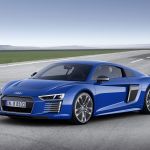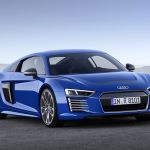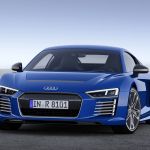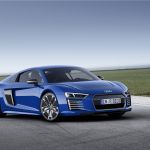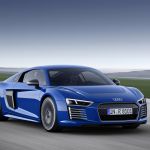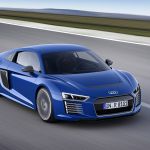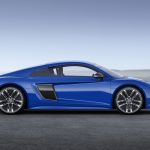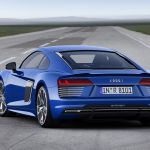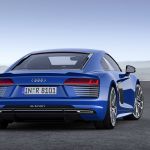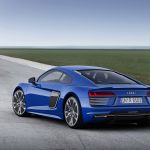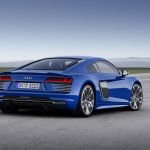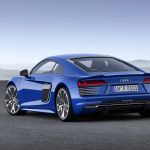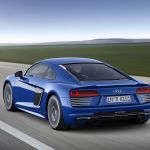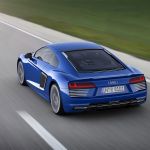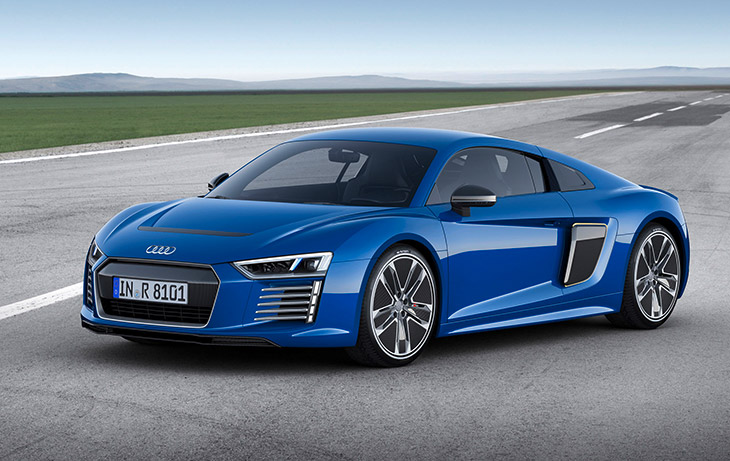 No model with the four rings is closer to motorsport, none is more striking and more dynamic: at the 2015 Geneva Motor Show, Audi is presenting the second generation of its high-performance R8 sports car. The V10 mid-engine and a newly developed quattro drive ensure breathtaking driving performance, especially in the top-of-the-range version with 449 kW (610 hp): achieving 0 to 100 km/h (62.1 mph) in just 3.2 seconds, its top speed is 330 km/h (205.1 mph).
No model with the four rings is closer to motorsport, none is more striking and more dynamic: at the 2015 Geneva Motor Show, Audi is presenting the second generation of its high-performance R8 sports car. The V10 mid-engine and a newly developed quattro drive ensure breathtaking driving performance, especially in the top-of-the-range version with 449 kW (610 hp): achieving 0 to 100 km/h (62.1 mph) in just 3.2 seconds, its top speed is 330 km/h (205.1 mph).
A high-revving mid-engine with superior performance, a consistently lightweight construction concept and an extremely dynamic chassis with quattro drive system and fully variable torque control – this is what makes the R8 the sporty spearhead of Audi. The high-performance sports car has been newly developed from the ground up – it is more taut, more striking and more fascinating both on the race track and on the road.
“Motorsport is in Audi’s genes, it has always been a permanent feature of our brand’s character,” says Prof. Dr. Ulrich Hackenberg, Board Member for Technical Development at Audi. “With the new Audi R8, our engineers are bringing accumulated racing expertise from the race track onto the road. No other model of ours evokes more dynamic emotion. The new R8 V10 plus is therefore the most powerful and fastest series-production Audi of all time.” Thanks to the close cooperation between racing engineers, racing drivers and developers, the Audi R8 has seen a clear performance increase – this benefits both the series production car and the R8 LMS developed on the basis of this.
The new Audi R8
The R8 is the dynamic spearhead of Audi. In its second generation, the high-performance sports car has been newly developed from the ground up – it is more taut, more striking and more fascinating. The high-revving V10 engine is available in two performance variants. In the top-of-the-range version with 449 kW (610 hp), it develops breathtaking power.
“Motorsport is in Audi’s DNA, it is part of our brand’s character,” says Prof. Dr. Ulrich Hackenberg, Board Member for Technical Development at Audi. “With the new R8, our engineers are bringing accumulated racing expertise from the race track onto the road. No other model of ours evokes more dynamic emotion, none is closer to a race car. The new R8 V10 plus is the most powerful and fastest series production Audi of all time.”
The mid-engine principle used for the Audi R8 is not only a classic concept in motorsport but also an important piece of Audi tradition. The powerful engines were located in front of the rear axle even in the Grand Prix race cars brought to the start line by Auto Union in the 1930s – a revolutionary step at the time. In 2000, Audi won the 24-hour Le Mans endurance race with the LMP R8 prototype for the first time. By 2005, the car which provided the name for today’s series-production high-performance sports car had secured five overall victories at the Sarthe – the name chosen for the road version of the super sports car from Audi, R8, indicates the technological relationship between the two winners.

As the R8 LMS, the Audi R8 is also highly successful in customer racing. The basis for its success: motorsport was part of the development strategy from the very beginning. In 2009, the R8 LMS customer racing race car began its success story which would lead it to more than 190 victories and 23 championship titles worldwide. Technically speaking, it is closely related to the road version of the sports car with around 50 percent of the same parts.
Design: flat, wide, muscular
A cockpit positioned very far forward, a long, flowing back and a relatively short wheelbase – the exterior design makes the technical concept of the mid-engine, high-performance Audi R8 sports car clear upon first sight. At 4.42 meters long (14.5 ft), 1.24 meters high (4.1 ft) and with a wheelbase measuring 2.65 meters (8.7 ft), its dimensions have only slightly changed in comparison to the previous model. Its width now measures 1.94 meters (6.4 ft) and has thus grown by about four centimeters (1.6 in). The car’s proportions convey more of a race car character, with characteristic design ideas from the previous model now more pronounced.
The four rings sit proudly on the hood, the Singleframe radiator grille with honeycomb design is wide and flat. Modeled plastic surfaces allow it to merge into the flat headlights – facets of the vehicle which highlight tension, provide an impression of depth and add an air of logic to the design. The grid-type signature of the daytime running lights with vertical elements replicates the structure of the air inlets and emphasizes the width of the car. The entire appearance of the Audi R8 conveys a feeling of lightness and technical precision. LED headlights are standard. Available upon request, Audi can also supply the laser spot which doubles the range of the high beam to 600 meters (1,968.5 ft) as well as the dynamic turn signals at the front. The dynamic turn signals are standard at the rear. The rear lighting signature also combines two vertical elements with a horizontal line. This gives the Audi R8 an even more powerful appearance.
As part of the new laser high beams, one laser module per headlight generates a cone of light with twice the range of the all-LED headlamp. Each module comprises four high-power laser diodes. With a diameter of just 300 micrometers, these generate a blue laser beam with a wavelength of 450 nanometers. A phosphor converter transforms it into white light suitable for roadway use with a color temperature of 5,500 Kelvin – ideal conditions for the human eye that enable the driver to recognize contrast more easily and help to prevent fatigue. The laser spot is active from a speed of 60 km/h (37.3 mph) to supplement the LED high beam of the R8 and, thanks to its long range, greatly enhances the driver’s field of vision as well as safety. An intelligent camera-based sensor system detects other road users and actively adjusts the light pattern to exclude them.
On the sides of the high-performance sports car, characteristically curved contours are drawn over the wheels. The shoulder line, shaped like a powerful muscle, connects the wheels with one another while at the same time dividing the side blade in two to leave an upper and a lower half. This new design solution makes the car appear even longer and more dynamic.
At the rear, as well, the lights and the air inlets visually connect to one another. The two tailpipes of the exhaust system have a trapezoidal design and the rear window offers a clear view of the illuminated engine compartment. The R8 is equipped with an electrically extending spoiler, the R8 V10 plus with a fixed wing made from CFRP.
2016 Audi R8 e-tron
Source: Audi
